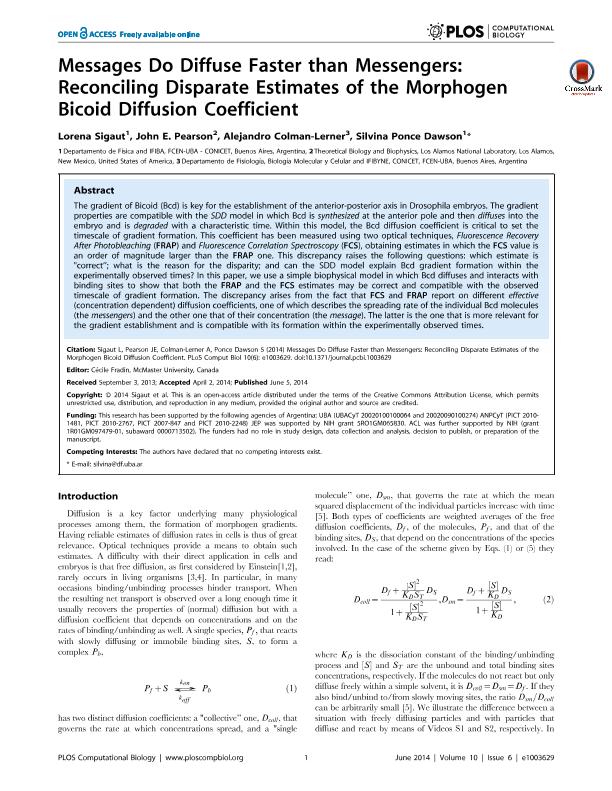Mostrar el registro sencillo del ítem
dc.contributor.author
Sigaut, Lorena

dc.contributor.author
Pearson, John E.
dc.contributor.author
Colman Lerner, Alejandro Ariel

dc.contributor.author
Ponce Dawson, Silvina Martha

dc.date.available
2017-06-12T20:42:08Z
dc.date.issued
2014-04
dc.identifier.citation
Sigaut, Lorena; Pearson, John E.; Colman Lerner, Alejandro Ariel; Ponce Dawson, Silvina Martha; Messages Do Diffuse Faster Than Messengers: Reconciling disparate estimates of the morphogen Bicoid diffusion coefficient; Public Library Of Science; Plos Computational Biology; 10; 6; 4-2014; 1-15; e1003629
dc.identifier.issn
1553-734X
dc.identifier.uri
http://hdl.handle.net/11336/18030
dc.description.abstract
The gradient of Bicoid (Bcd) is key for the establishment of the anterior-posterior axis in Drosophila embryos. The gradient properties are compatible with the SDD model in which Bcd is synthesized at the anterior pole and then diffuses into the embryo and is degraded with a characteristic time. Within this model, the Bcd diffusion coefficient is critical to set the timescale of gradient formation. This coefficient has been measured using two optical techniques, Fluorescence Recovery After Photobleaching (FRAP) and Fluorescence Correlation Spectroscopy (FCS), obtaining estimates in which the FCS value is an order of magnitude larger than the FRAP one. This discrepancy raises the following questions: which estimate is ?correct?; what is the reason for the disparity; and can the SDD model explain Bcd gradient formation within the experimentally observed times. In this paper, we use a simple biophysical model in which Bcd diffuses and interacts with binding sites to show that both the FRAP and the FCS estimates may be correct and compatible with the observed timescale of gradient formation. The discrepancy arises from the fact that FCS and FRAP report on different effective (concentration dependent) diffusion coefficients, one of which describes the spreading rate of the individual Bcd molecules (the messengers) and the other one that of their concentration (the message). The latter is the one that is more relevant for the gradient establishment and is compatible with its formation within the experimentally observed times.
dc.format
application/pdf
dc.language.iso
eng
dc.publisher
Public Library Of Science

dc.rights
info:eu-repo/semantics/openAccess
dc.rights.uri
https://creativecommons.org/licenses/by-nc-sa/2.5/ar/
dc.subject
Development
dc.subject
Quantitative Microscopy
dc.subject
Diffusion
dc.subject
Bicoid
dc.subject.classification
Biofísica

dc.subject.classification
Ciencias Biológicas

dc.subject.classification
CIENCIAS NATURALES Y EXACTAS

dc.title
Messages Do Diffuse Faster Than Messengers: Reconciling disparate estimates of the morphogen Bicoid diffusion coefficient
dc.type
info:eu-repo/semantics/article
dc.type
info:ar-repo/semantics/artículo
dc.type
info:eu-repo/semantics/publishedVersion
dc.date.updated
2017-06-09T14:19:21Z
dc.journal.volume
10
dc.journal.number
6
dc.journal.pagination
1-15; e1003629
dc.journal.pais
Estados Unidos

dc.journal.ciudad
San Francisco
dc.description.fil
Fil: Sigaut, Lorena. Consejo Nacional de Investigaciones Científicas y Técnicas. Oficina de Coordinación Administrativa Ciudad Universitaria. Instituto de Física de Buenos Aires. Universidad de Buenos Aires. Facultad de Ciencias Exactas y Naturales. Instituto de Física de Buenos Aires; Argentina
dc.description.fil
Fil: Pearson, John E.. Los Alamos National Laboratory;
dc.description.fil
Fil: Colman Lerner, Alejandro Ariel. Consejo Nacional de Investigaciones Científicas y Técnicas. Oficina de Coordinación Administrativa Ciudad Universitaria. Instituto de Fisiología, Biología Molecular y Neurociencias. Universidad de Buenos Aires. Facultad de Ciencias Exactas y Naturales. Instituto de Fisiología, Biología Molecular y Neurociencias; Argentina
dc.description.fil
Fil: Ponce Dawson, Silvina Martha. Consejo Nacional de Investigaciones Científicas y Técnicas. Oficina de Coordinación Administrativa Ciudad Universitaria. Instituto de Física de Buenos Aires. Universidad de Buenos Aires. Facultad de Ciencias Exactas y Naturales. Instituto de Física de Buenos Aires; Argentina
dc.journal.title
Plos Computational Biology

dc.relation.alternativeid
info:eu-repo/semantics/altIdentifier/url/http://journals.plos.org/ploscompbiol/article?id=10.1371/journal.pcbi.1003629
dc.relation.alternativeid
info:eu-repo/semantics/altIdentifier/doi/http://dx.doi.org/10.1371/journal.pcbi.1003629
Archivos asociados
